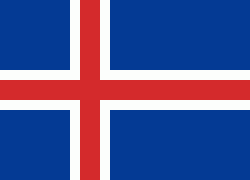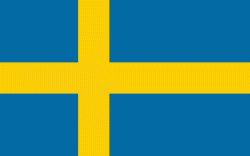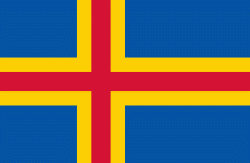Swedish language
Swedish (svenska ) is a North Germanic language spoken predominantly in Sweden and in parts of Finland. It has at least 10 million native speakers, the fourth most spoken Germanic language and the first among any other of its type in the Nordic countries overall.
Swedish, like the other Nordic languages, is a descendant of Old Norse, the common language of the Germanic peoples living in Scandinavia during the Viking Era. It is largely mutually intelligible with Norwegian and Danish, although the degree of mutual intelligibility is largely dependent on the dialect and accent of the speaker. Written Norwegian and Danish are usually more easily understood by Swedish speakers than the spoken languages, due to the differences in tone, accent, and intonation.
Standard Swedish, spoken by most Swedes, is the national language that evolved from the Central Swedish dialects in the 19th century and was well established by the beginning of the 20th century. While distinct regional varieties and rural dialects still exist, the written language is uniform and standardized. Swedish is the most widely spoken second language in Finland where it has status as co-official language.
Swedish was long spoken in parts of Estonia, although the current status of the Estonian Swedish speakers is almost extinct. It is also used in the Swedish diaspora, most notably in Oslo, Norway, with more than 50,000 Swedish residents.
Swedish is an Indo-European language belonging to the North Germanic branch of the Germanic languages. In the established classification, it belongs to the East Scandinavian languages, together with Danish, separating it from the West Scandinavian languages, consisting of Faroese, Icelandic, and Norwegian. However, more recent analyses divide the North Germanic languages into two groups: Insular Scandinavian (Faroese and Icelandic), and Continental Scandinavian (Danish, Norwegian, and Swedish), based on mutual intelligibility due to heavy influence of East Scandinavian (particularly Danish) on Norwegian during the last millennium and divergence from both Faroese and Icelandic.
By many general criteria of mutual intelligibility, the Continental Scandinavian languages could very well be considered dialects of a common Scandinavian language. However, because of several hundred years of sometimes quite intense rivalry between Denmark and Sweden, including a long series of wars from the 16th to 18th centuries, and the nationalist ideas that emerged during the late 19th and early 20th centuries, the languages have separate orthographies, dictionaries, grammars, and regulatory bodies. Danish, Norwegian, and Swedish are thus from a linguistic perspective more accurately described as a dialect continuum of Scandinavian (North Germanic), and some of the dialects, such as those on the border between Norway and Sweden, especially parts of Bohuslän, Dalsland, western Värmland, western Dalarna, Härjedalen, Jämtland, and Scania, could be described as intermediate dialects of the national standard languages.
Swedish pronunciations also vary greatly from one region to another, a legacy of the vast geographic distances and historical isolation. Even so, the vocabulary is standardized to a level that make dialects within Sweden virtually fully mutually intelligible.
Swedish, like the other Nordic languages, is a descendant of Old Norse, the common language of the Germanic peoples living in Scandinavia during the Viking Era. It is largely mutually intelligible with Norwegian and Danish, although the degree of mutual intelligibility is largely dependent on the dialect and accent of the speaker. Written Norwegian and Danish are usually more easily understood by Swedish speakers than the spoken languages, due to the differences in tone, accent, and intonation.
Standard Swedish, spoken by most Swedes, is the national language that evolved from the Central Swedish dialects in the 19th century and was well established by the beginning of the 20th century. While distinct regional varieties and rural dialects still exist, the written language is uniform and standardized. Swedish is the most widely spoken second language in Finland where it has status as co-official language.
Swedish was long spoken in parts of Estonia, although the current status of the Estonian Swedish speakers is almost extinct. It is also used in the Swedish diaspora, most notably in Oslo, Norway, with more than 50,000 Swedish residents.
Swedish is an Indo-European language belonging to the North Germanic branch of the Germanic languages. In the established classification, it belongs to the East Scandinavian languages, together with Danish, separating it from the West Scandinavian languages, consisting of Faroese, Icelandic, and Norwegian. However, more recent analyses divide the North Germanic languages into two groups: Insular Scandinavian (Faroese and Icelandic), and Continental Scandinavian (Danish, Norwegian, and Swedish), based on mutual intelligibility due to heavy influence of East Scandinavian (particularly Danish) on Norwegian during the last millennium and divergence from both Faroese and Icelandic.
By many general criteria of mutual intelligibility, the Continental Scandinavian languages could very well be considered dialects of a common Scandinavian language. However, because of several hundred years of sometimes quite intense rivalry between Denmark and Sweden, including a long series of wars from the 16th to 18th centuries, and the nationalist ideas that emerged during the late 19th and early 20th centuries, the languages have separate orthographies, dictionaries, grammars, and regulatory bodies. Danish, Norwegian, and Swedish are thus from a linguistic perspective more accurately described as a dialect continuum of Scandinavian (North Germanic), and some of the dialects, such as those on the border between Norway and Sweden, especially parts of Bohuslän, Dalsland, western Värmland, western Dalarna, Härjedalen, Jämtland, and Scania, could be described as intermediate dialects of the national standard languages.
Swedish pronunciations also vary greatly from one region to another, a legacy of the vast geographic distances and historical isolation. Even so, the vocabulary is standardized to a level that make dialects within Sweden virtually fully mutually intelligible.
Country
-
Finland
Finland (Suomi ; Finland ), officially the Republic of Finland (Suomen tasavalta; Republiken Finland ), is a Nordic country in Northern Europe. It shares land borders with Sweden to the northwest, Norway to the north, and Russia to the east, with the Gulf of Bothnia to the west and the Gulf of Finland to the south, across from Estonia. Finland covers an area of 338455 km2 with a population of 5.6 million. Helsinki is the capital and largest city. The vast majority of the population are ethnic Finns. Finnish and Swedish are the official languages, Swedish is the native language of 5.2% of the population. Finland's climate varies from humid continental in the south to the boreal in the north. The land cover is primarily a boreal forest biome, with more than 180,000 recorded lakes.
Finland was first inhabited around 9000 BC after the Last Glacial Period. The Stone Age introduced several different ceramic styles and cultures. The Bronze Age and Iron Age were characterized by contacts with other cultures in Fennoscandia and the Baltic region. From the late 13th century, Finland became a part of Sweden as a consequence of the Northern Crusades. In 1809, as a result of the Finnish War, Finland became part of the Russian Empire as the autonomous Grand Duchy of Finland, during which Finnish art flourished and the idea of independence began to take hold. In 1906, Finland became the first European state to grant universal suffrage, and the first in the world to give all adult citizens the right to run for public office. After the 1917 Russian Revolution, Finland declared independence from Russia. In 1918, the fledgling state was divided by the Finnish Civil War. During World War II, Finland fought the Soviet Union in the Winter War and the Continuation War, and Nazi Germany in the Lapland War. It subsequently lost parts of its territory, but maintained its independence. -
Iceland
Iceland (Ísland, ) is a Nordic island country in the North Atlantic Ocean and in the Arctic Ocean. Iceland is the most sparsely populated country in Europe. Iceland's capital and largest city is Reykjavík, which is home to about 36% of the population. Iceland is the largest part of the Mid-Atlantic Ridge that rises above sea level, and its central volcanic plateau is erupting almost constantly. The interior consists of a plateau characterised by sand and lava fields, mountains, and glaciers, and many glacial rivers flow to the sea through the lowlands. Iceland is warmed by the Gulf Stream and has a temperate climate, despite a high latitude just outside the Arctic Circle. Its high latitude and marine influence keep summers chilly, and most of its islands have a polar climate.
According to the ancient manuscript Landnámabók, the settlement of Iceland began in 874 AD when the Norwegian chieftain Ingólfr Arnarson became the first permanent settler on the island. In the following centuries, Norwegians, and to a lesser extent other Scandinavians, immigrated to Iceland, bringing with them thralls (i.e., slaves or serfs) of Gaelic origin. -
Sweden
Sweden, formally the Kingdom of Sweden, is a Nordic country located on the Scandinavian Peninsula in Northern Europe. It borders Norway to the west and north, Finland to the east, and is connected to Denmark in the southwest by a bridge–tunnel across the Öresund. At 447425 km2, Sweden is the largest Nordic country, the third-largest country in the European Union, and the fifth-largest country in Europe. The capital and largest city is Stockholm. Sweden has a total population of 10.5 million, and a low population density of 25.5 PD/km2, with around 87% of Swedes residing in urban areas, which cover 1.5% of the entire land area, in the central and southern half of the country.
Nature in Sweden is dominated by forests and many lakes, including some of the largest in Europe. Many long rivers run from the Scandes range through the landscape, primarily emptying into the northern tributaries of the Baltic Sea. It has an extensive coastline and most of the population lives near a major body of water. With the country ranging from 55°N to 69°N, the climate of Sweden is diverse due to the length of the country. The usual conditions are mild for the latitudes with a maritime south, continental centre and subarctic north. Snow cover is infrequent in the densely populated south, but reliable in higher latitudes. Furthermore, the rain shadow of the Scandes results in quite dry winters and sunny summers in much of the country. -
Åland Islands
Åland (Ahvenanmaa: ) is an autonomous and demilitarised region of Finland since 1920 by a decision of the League of Nations. It is the smallest region of Finland by area and population, with a size of 1,580 km2, and a population of 30,129, constituting 0.51% of its land area and 0.54% of its population. Its only official language is Swedish and the capital city is Mariehamn.
Åland is situated in an archipelago, called the Åland Islands, at the entrance to the Gulf of Bothnia in the Baltic Sea belonging to Finland. It comprises Fasta Åland on which 90% of the population resides and about 6,500 skerries and islands to its east. Of Åland's thousands of islands, about 60–80 are inhabited. Fasta Åland is separated from the coast of Roslagen in Sweden by 38 km of open water to the west. In the east, the Åland archipelago is contiguous with the Finnish archipelago. Åland's only land border is located on the uninhabited skerry of Märket, which it shares with Sweden. From Mariehamn, there is a ferry distance of about 160 km to Turku, a coastal city of mainland Finland, and also to Stockholm, the capital of Sweden.
